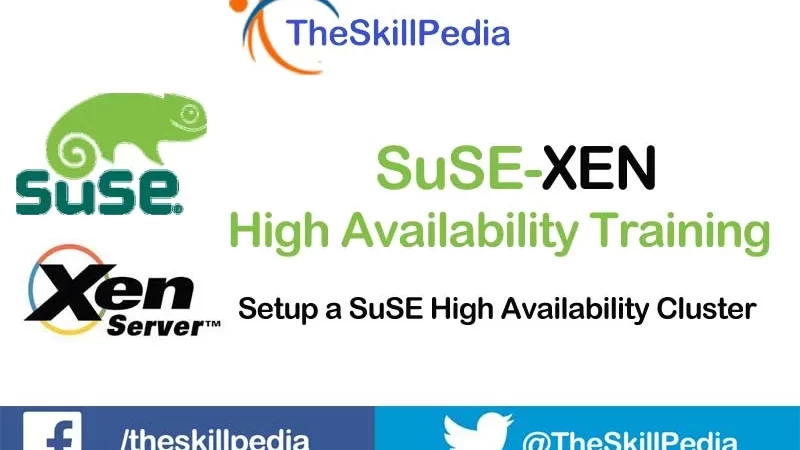XEN VIRTUALIZATION & HA
The XEN VIRTUALIZATION & HA - SuSE XEN Training program is designed for linux professionals who are already working on Linux.
Introduction to Virtualization
- Virtualization – Definition and History
- Virtualization Advantages
- Types of virtualization : Full vs. Para-virtualization
- Memory virtualization and Device and I/O Virtualization
- Type-1 vs. Type-2 Virtualization : Xen: Type-1 VMM, KVM: Type-2 VMM
- Hypervisor : Types of hypervisor
- Vmware – Pros and Cons
- VirtualBox – pros and Cons
- XEN – features
- Xen Virtualization Architecture
- XEN Pros and Cons
- KVM Pros and Cons
Session 2. Virtualization at SuSE
- Virtualization at SUSE
- Enhancements in XEN
- Enhancements in Linux Containers
- Virtualization with VMware
- Virtualization with Microsoft
- Virtualization in the Clouds
- Supported Virtualization Limits
- Supported VM Guests
- Supported VM Hosts
Lab 1 : Prepare the Setup : Install SuSE
Setting up a Virtual Machine Host
- Best Practices and Suggestions
- Managing Domain0 Memory
- Network Card in Fully Virtualized Guests
- Starting the Virtual Machine Host
- PCI Pass-Through
Lab 2 : Understanding the Environment
- Creating
- Configuring
- Starting and stopping
- Deleting
- Managing a virtualized environment
- Cloning
Lab 3. Create First Virtual Machine
Advanced Techniques in VM Management
- Create a Bond Device
- Create the Network Bridge
- Bond Link Failure
- Create a VM with the XVM. Create Script.
Lab 4 : Manage your VM
Manage the Virtualization Environment
- Serial Console Access
- Xen Manager Xm Command
- Xen VM Startup
- Shut Down Xen VM
- Monitor Xen VM
- Monitor Performance with XenMon
- Monitor Performance with XenTop
- High Availability Hot Standby
- High Availability Warm Remote Stand by.
Lab 5 Configuring Load Balancing
ADANCED TOPICS
Managing a Virtualization Environment
- Virtual Machine Manager
- Controlling the Host by Modifying Xend Settings
- Configuring a Virtual Machine by Modifying its Xend Settings
- The xm Command
- Automatic Starting of Domains
- Migrating Xen VM Guest Systems
Lab 6 Xen VM Live Migration
Session 8. Virtual Networking
- Virtual Bridges
- Network Devices for Guest Systems
- Host Based Routing in Xen
- Creating a Masqueraded Network Setup
- Special Configurations
Lab 7 Configuring a routed IPv4 VM Guest
Day 5
Session 9. Administration Tasks
- The Boot Loader Program
- Sparse Image Files and Disk Space
- Migrating Virtual Machines
- Passing Key Combinations to Virtual Machines
- Monitoring Xen
- Extra Guest Descriptions in Xen Configuration
- Providing Host Information for VM Guest Systems
Lab 8 Configuring a masqueraded IPv4 VM Guest
Session 10. Save and Restore of Virtual Machines
- Saving Virtual Machines
- Restoring Virtual Machines
- Virtual Machine States
- Xen as High Availability Virtualization Host:
- Xen HA with Remote Storage
- Xen HA with Local Storage
- Xen HA and Private Bridges
Lab 9 Managing Cluster Resources-I
Day 6
Session 11. Configuring and Managing High Availability Cluster using Xen -I
- Understanding Important Terms
- Exploring the Existing Configuration
- Adding a Resource
- Perform a Failover
- Quorum and Two-Node Clusters
- Prevent Resources from Moving after Recovery
- Apache - Adding More Services
- Update the Configuration
- Ensuring Resources Run on the Same Host
- Controlling Resource Start/Stop Ordering
- Specifying a Preferred Location
Lab 10 Creating Cluster Resources-II
Session 12. Configuring and Managing High Availability Cluster using Xen -II
- Manually Moving Resources Around the Cluster
- Giving Control Back to the Cluster
- Using DRBD for Shared Storage
- Configure DRBD
- Configure LVM
- Create A Partition for DRBD
- Write the DRBD Config
- Initialize and Load DRBD
- Populate DRBD with Data
- Configure the Cluster for DRBD
- Testing Migration
Lab 11 DRBD Configuration
Bonus Labs:
Lab 1 Configuring and working with High Availability using Command Line
Lab 2. Configure drbd and openais for host xen Virtual Machine
Lab 3 Using DRBD for Xen Virtual Host
Lab 4 Using OCFS2
